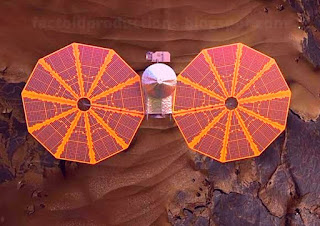NASA Lucy mission: NASA's plan to tour the Trojan asteroids
 |
| Lucy spacecraft |
In 2017, NASA chose two exploration missions called Lucy and Psyche. Both are meant to study long distant asteroids. Lucy will launch in 2021 and psyche in 2023.
The Lucy spacecraft will meet seven asteroids in a period of 12 years. These asteroids are located about 4 billion miles from Earth. They stay in the Lagrange points of Jupiter.
Lagrange Point
If you want to know what Lagrange point is.
These are the points at which a satellite or celestial body lies in a stable position. We usually use these points to stabilize satellites on Earth.
But in this case, Lucy will meet asteroids that were stationed at Lagrange points 4 and 5 in Jupiter.
Lucy mission launch date
This spacecraft will be launched aboard an Atlas 5 rocket on October 16, 2021. As of today(August 20, 2021), the Lucy spacecraft is now transported to the launch site.
Here are 5 things you should know about NASA's Lucy mission:
1. This Lucy spacecraft has an actual time capsule
You heard it right. There is a time capsule. This time capsule has a plaque.
In this, there is a depiction of the present solar system and has messages from great authors and Nobel laureates.
These messages are about wisdom, joy, and inspiration for the future human civilization.
The reason why there is a time capsule is that when this mission ends, this spacecraft will still be in orbit for a million years.
So there is a high chance that future astronauts will retrieve this spacecraft when humanity starts to explore the outer planets.
This time capsule is installed on the spacecraft in a ceremony at Lockheed Martin on July 9th, 2021.
Click here to check out the message recorded to be delivered to future generations.
2. This spacecraft is named after a fossil
It's true. Lucy is the name of a fossilized skeleton that belongs to female hominin species dating back 3.2 million years.
This fossil helps us in understanding human evolution.
This spacecraft is named after this because it might unlock various fossils of planet formation thus helping us to find more about the early days of the solar system.
3. Lucy is about 42 feet long
The entire spacecraft accounts for about 30 meters (42 feet).
The antenna placed on the lucy spacecraft is 6.5 feet long. Radio signals are transferred through this antenna back to earth.
4. Lucy will meet the Trojan asteroids only after 6 years
As these asteroids are at a distance of 4 billion miles from Earth, it would take Lucy 6 years to get there.
On its way, Lucy will rendezvous with the Johansson asteroid, where she will test all of its instruments to do a rehearsal.
Then Lucy will be headed towards the first set of Trojan asteroids.
This spacecraft reaches the first set of Trojan asteroids on August 2027 and the second set of Trojan asteroids in 2033.
5. Lucy is not designed to orbit any asteroid
This spacecraft is not designed to orbit any asteroid but instead, it will make a fly-by to take high-resolution images
Lucy spacecraft Instruments
This spacecraft has three cameras and two spectrometers.
- MVIC - color camera of wavelength 0.4 to 0.85 micron
- T2CAM - to take wide images
- L'LORRI - high-quality images of wavelength 0.35 to 0.85 micron
and also 2 infrared spectrometers
These instruments will help us in finding the surface geology, color, and components of these asteroids.
Lucy Mission Target Asteroids
These are the asteroids Lucy is supposed to meet
Donald Johanson - 4 km diameter- smallest of all the targets
L4 point
Eurybates - 64 km diameter(40 miles)
Polymele - 21 km diameter(13 miles)- is said to be an organic asteroid
Leucus - 21 km diameter(13 miles)
Orus - 51 km diameter(31.6 miles)
L5 point
Patroclus - 113 km diameter(70 miles)- biggest of all its targets
Menoetius - 104 km diameter(65 miles)
Both of these are binary asteroids
Conclusion
This exploration mission will help us unravel the true history of the solar system. It is also so exciting to know that there is a time capsule for future generations.
Are you excited about this? Tell us in the comments
Check here for Mission Animations









0 Comments